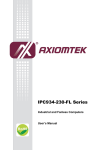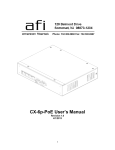Download IPC914 Series Industrial & Embedded Computers User`s Manual
Transcript
IPC914 Series Industrial & Embedded Computers User’s Manual Disclaimers This manual has been carefully checked and believed to contain accurate information. AXIOMTEK Co., Ltd. assumes no responsibility for any infringements of patents or any third party’s rights, and any liability arising from such use. AXIOMTEK does not warrant or assume any legal liability or responsibility for the accuracy, completeness or usefulness of any information in this document. AXIOMTEK does not make any commitment to update the information in this manual. AXIOMTEK reserves the right to change or revise this document and/or product at any time without notice. No part of this document may be reproduced, stored in a retrieval system, or transmitted, in any form or by any means, electronic, mechanical, photocopying, recording, or otherwise, without the prior written permission of AXIOMTEK Co., Ltd. ©Copyright 2009 AXIOMTEK Co., Ltd. All Rights Reserved Dec 2009, Version A2 Printed in Taiwan ii Safety Precautions Before getting started, please read the following important safety precautions. 1. 2. 3. 4. The IPC914 Series does not come equipped with an operating system. An operating system must be loaded first before installing any software into the computer. Be sure to ground yourself to prevent static charge when installing the internal components. Use a grounding wrist strap and place all electronic components in any staticshielded devices. Most electronic components are sensitive to static electrical charge. Disconnect the power cord from the IPC914 Series before making any installation. Be sure both the system and the external devices are turned OFF. Sudden surge of power could ruin sensitive components. Make sure the IPC914 Series is properly grounded. Make sure the voltage of the power source is correct before connecting the equipment to the power outlet. 5. Turn OFF the system power before cleaning. Clean the system using a cloth only. Do not spray any liquid cleaner directly onto the screen. 6. Do not leave this equipment in an uncontrolled environment where the storage temperature is below -20℃ or above 60℃. It may damage the equipment. 7. Do not open the system’s back cover. If opening the cover for maintenance is a must, only a trained technician is allowed to do so. Integrated circuits on computer boards are sensitive to static electricity. To avoid damaging chips from electrostatic discharge, observe the following precautions: Before handling a board or integrated circuit, touch an unpainted portion of the system unit chassis for a few seconds. This will help to discharge any static electricity on your body. When handling boards and components, wear a wristgrounding strap, available from most electronic component stores. iii Classification 1. 2. 3. 4. 5. Degree of production against electric shock: not classified Degree of protection against the ingress of water: IPX0 Equipment not suitable for use in the presence of a flammable anesthetic mixture with air or with oxygen or nitrous oxide. Mode of operation: Continuous Type of protection against electric shock: Class I equipment General Cleaning Tips You may need the following precautions before you begin to clean the computer. When you clean any single part or component for the computer, please read and understand the details below fully. When you need to clean the device, please rub it with a piece of dry cloth. 1. Be cautious of the tiny removable components when you use a vacuum cleaner to absorb the dirt on the floor. 2. Turn the system off before you start to clean up the component or computer. 3. Never drop the components inside the computer or get circuit board damp or wet. 4. Be cautious of all kinds of cleaning solvents or chemicals when you use it for the sake of cleaning. Some individuals may be allergic to the ingredients. 5. Try not to put any food, drink or cigarette around the computer. Cleaning Tools: Although many companies have created products to help improve the process of cleaning your computer and peripherals users can also use household items to clean their computers and peripherals. Below is a listing of items you may need or want to use while cleaning your computer or computer peripherals. Keep in mind that some components in your computer may only be able to be cleaned using a product designed for cleaning that component, if this is the case it will be mentioned in the cleaning. z Cloth: A piece of cloth is the best tool to use when rubbing up iv z z z z a component. Although paper towels or tissues can be used on most hardware as well, we still recommend you to rub it with a piece of cloth. Water or rubbing alcohol: You may moisten a piece of cloth a bit with some water or rubbing alcohol and rub it on the computer. Unknown solvents may be harmful to the plastics parts. Vacuum cleaner: Absorb the dust, dirt, hair, cigarette particles, and other particles out of a computer can be one of the best methods of cleaning a computer. Over time these items can restrict the airflow in a computer and cause circuitry to corrode. Cotton swabs: Cotton swaps moistened with rubbing alcohol or water are excellent tools for wiping hard to reach areas in your keyboard, mouse, and other locations. Foam swabs: Whenever possible it is better to use lint free swabs such as foam swabs. Note It is strongly recommended that you should shut down the system before you start to clean any single components. Please follow the steps below: 1. Close all application programs 2. Close operating software 3. Turn off power switch 4. Remove all device 5. Pull out power cable v Scrap Computer Recycling If the computer equipments need the maintenance or are beyond repair, we strongly recommended that you should inform your AXIOMTEK distributor as soon as possible for the suitable solution. For the computers that are no longer useful or no longer working well, please contact your AXIOMTEK distributor for recycling and we will make the proper arrangement. Trademarks Acknowledgments AXIOMTEK is a trademark of AXIOMTEK Co., Ltd. IBM, PC/AT, PS/2, VGA are trademarks of International Business Machines Corporation. ® ® Intel and Pentium are registered trademarks of Intel Corporation. MS-DOS, Microsoft C and QuickBASIC are trademarks of Microsoft Corporation. VIA is a trademark of VIA Technologies, Inc. SST is a trademark of Silicon Storage Technology, Inc. UMC is a trademark of United Microelectronics Corporation. Other brand names and trademarks are the properties and registered brands of their respective owners. vi Table of Contents Disclaimers ........................................................................................................... ii Safety Precautions .............................................................................................. iii Classification ........................................................................................................iv General Cleaning Tips .........................................................................................iv Scrap Computer Recycling .................................................................................vi CHAPTER 1 INTRODUCTION ..................................................................................... 1 1.1 General Description................................................................................. 1 1.2 System Specifications ............................................................................. 2 1.2.1 Main CPU Board .............................................................................. 2 1.2.2 I/O System....................................................................................... 3 1.2.3 System Specification ....................................................................... 3 1.3 Dimensions.............................................................................................. 5 1.4 I/O Outlets ............................................................................................... 6 1.5 Jumper Settings ...................................................................................... 7 1.6 Packing List ............................................................................................. 9 CHAPTER 2 HARDWARE INSTALLATION .............................................................. 11 2.1 Installing the Processor ......................................................................... 11 2.2 Installing the Memory Module ............................................................... 15 2.3 Installing the Hard Disk Drive ................................................................ 17 2.4 Installing the PCI Card (when Backplane HAB104 installed) ................ 19 CHAPTER 3 PHOENIX-AWARD BIOS UTILITY ....................................................... 22 3.1 Entering Setup....................................................................................... 22 3.2 Control Keys .......................................................................................... 23 3.3 Getting Help .......................................................................................... 23 3.4 The Main Menu ..................................................................................... 24 3.5 Standard CMOS Setup Menu................................................................ 25 3.6 Advanced BIOS Features...................................................................... 28 3.7 Advanced Chipset Features .................................................................. 34 3.8 Integrated Peripherals ........................................................................... 36 3.9 Power Management Setup .................................................................... 43 3.10 PnP/PCI Configuration Setup................................................................ 47 3.11 PC Health Status................................................................................... 49 3.12 Frequency/Voltage Control.................................................................... 50 3.13 Load Optimized Defaults ....................................................................... 51 3.14 Set Supervisor/User Password ............................................................. 52 3.15 Save & Exit Setup ................................................................................. 53 3.16 Exit Without Saving ............................................................................... 54 vii MEMO viii IPC914 Series User’s Manual CHAPTER 1 INTRODUCTION This chapter contains general information and a detailed specification of the IPC914 Series. Chapter 1 includes the following sections: 1.1 General Description System Specification Dimensions I/O Outlets Package List General Description The IPC914 Series is an embedded system that can support Socket ® M for Intel Core TM TM 2 Duo/ Core ® Duo or Celeron M processors. ® ® The IPC914 Series supports Windows 2000, Windows XP, and ® Windows XP embedded, suitable for the most endurable operation. Introduction 1 IPC914 Series User’s Manual ¾ Reliable and Stable Design The IPC914 Series adopts an anti-vibration hard-drive bay, which makes it especially suitable for vibration environments, best for industrial automation, digital signage and gaming application. ¾ Embedded O.S. Supported ® The IPC914 Series not only supports Windows 2000, ® Windows XP, but also supports embedded OS, such as ® Windows XP embedded. For storage device, the IPC914 Series supports one 2.5" HDD driver bay and one onboard CompactFlash™ socket. 1.2 System Specifications 1.2.1 Main CPU Board z CPU z z Socket type Intel Core M processors System Chipset ® Intel 945GME chipset BIOS z Phoenix-Award BIOS, 4Mbit with RPL/PXE LAN Boot ROM, SmartView and Customer CMOS Backup. System Memory ® TM TM 2 Duo/ Core Duo or Celeron ® Two 200-pin DDR2 533/667 MHz SODIMM sockets, with maximum up to 4GB Features Fanless Operation Compact & Front IO design Supports four PCI or four PCI & PICe expansion slots DC to DC power supply support 10V to 30V z 2 Introduction IPC914 Series User’s Manual 1.2.2 z z z I/O System Standard I/O Interface -- Front ATX power on/off switch 10VDC to 30VDC with phoenix power plug or External 150W AC Adapter Two USB 2.0 ports HDD access/power LEDs One RS232(COM 2) One RD232-422-485(COM 1) One VGA connector Two G.E. LAN ports Optional I/O through bracket (Customer Selectable) Two COM port Four USB One DVI-D Expansion Slot Four PCI slots when backplane HAB104 installed Two PCI & One PCIex1 & One PCIex16 slots when backplane HAB105 installed NOTE 1.2.3 z System Specification Drive Capacity z The maximum power rating value for one expansion cards can’t exceed [email protected], +3.3V@1A,[email protected] Supports one 2.5” HDD driver bay; one onboard CompactFlash™ Socket Power Input 10VDC to 30VDC with phoenix power plug Introduction 3 IPC914 Series User’s Manual External 150W AC Adapter – Power Input – 90VAC to 264VAC, 7.89A 47/63HZ – Power Output – 19VDC Operation Temperature z Ambient with air flow: 0℃ ~ 45℃ Storage Temperature z -20℃ ~ 80℃ Humidity z 10% ~ 90% (Non-condensing) Dimensions z 182mm (7.2”) (W) x 248mm (9.8”) (D) x 185mm (7.3”) NOTE 4 All specifications and images are subject to change without notice. Introduction IPC914 Series User’s Manual 1.3 Dimensions The following diagrams show you dimensions and outlines of the IPC914 Series. Introduction 5 IPC914 Series User’s Manual 1.4 I/O Outlets The following figures show you I/O outlets on front and rear panels of the IPC914 Series. Front Panel 6 Introduction IPC914 Series User’s Manual 1.5 Jumper Settings The IPC914 has a number of jumpers inside the chassis that allow you to configure your system to suit your application. The table below lists the functions of the various jumpers. Jumper Description COM1 DCD & Normal RI (Default) Voltage Selection CMOS Jumper Setting Description Jumper Setting JP1 5V JP1 12V JP1 DCD/5V RI/12V JP1 Normal JP7 Clear CMOS JP7 JP6 Slave JP6 (Default) CF Master Master/Slave (Default) Introduction 7 IPC914 Series User’s Manual COM1 RS232/422/485 Jumper Setting Jumper COM1 LCD Voltage 8 Description Jumper Setting Description Jumper Setting RS-232 (Default) JP2 JP3 JP4 RS-422 JP2 JP3 JP4 RS-485 JP2 JP3 JP4 3.3V (Default) JP8 5V JP8 Introduction IPC914 Series User’s Manual 1.6 Packing List The package bundled with your IPC914 Series should contain the following items: z z z z z z IPC914 Series Unit x 1 19V 150W Adapter (for IPC914 AC Version) Driver CD Quick Manual Wall Mount Bracket x 2 HD Screw x 4 If you can not find this package or any items are missing, please contact AXIOMTEK distributors immediately. Introduction 9 IPC914 Series User’s Manual MEMO 10 Introduction IPC914 Series User’s Manual CHAPTER 2 HARDWARE INSTALLATION The IPC914 Series are convenient for your various hardware configurations, such as CPU (Central Processing Unit), Memory Module, HDD (Hard Disk Drive) and PCIe card. The chapter 2 will show you how to install the hardware. It includes: 2.1 Installing the Processor ® ® The Intel Pentium M Processor is available as a boxed processor for laptop computers in the micro-FCPGA form factor. Intel recommends the processor should be installed by a computer professional since this electronic device may cause serious damage to the installer, system and processor if installed improperly. Important Notes Before attempting to install a new processor, carefully review the documentation that came with your system and make sure that you will not be voiding your warranty by opening the computer or replacing your processor. Instructions: ® 1. Make sure that your system can accommodate the Intel ® Pentium M Processor that you want to install. Check for motherboard, BIOS, and thermal compatibility by using the manufacturer's documentation for the laptop computer, or by contacting the vendor if necessary. This processor should only ® ® be installed in systems supporting the Intel Pentium M Processor. ® 2. ® Important Notes Do not use an Intel Pentium M Processor in a desktop system and do not use a desktop processor in an ® ® Intel Pentium M Processor notebook. Since these processors have different electrical specifications, damage to the processor and system can occur. Obtain access to your processor socket as described in the documentation for your system. Hardware Installation 11 IPC914 Series User’s Manual 3. If the cooling solution prevents you from accessing the processor socket, you may need to remove it. Instructions on how to remove your cooling solution should be provided in the documentation that came with the system. To un-install the current processor, use a screwdriver to disengage (open) the socket actuator, as shown in Figure 1 below. (The most commonly used sockets are Molex* or FoxConn* sockets, so they are used in the illustrations below.) The socket actuator should open after only a half turn or so, and you should then be able to remove the processor with your fingers. 4. Procedure of Installation: Step 1 Turn off the system. Step 2 Disconnect the power connector. Step 3 Loosen screws to remove the top and side covers from the chassis. 12 Hardware Installation IPC914 Series User’s Manual Step 4 After opening the top and side covers, you can locate the CPU socket and heatsink as marked. Step 5 Align pins of the CPU with pin holes of the socket. Be careful of the CPU’s orientation that you need to align the arrow mark on the CPU with the arrow key on the socket. Place the CPU into the socket, and use a screwdriver to lock it onto the socket. Hardware Installation 13 IPC914 Series User’s Manual Step 6 Place the CPU Heatsink on the CPU, and lock it by pushing down the fixing buttons. Step 7 Close the side and top covers back to the chassis, and fasten all screws. 14 Hardware Installation IPC914 Series User’s Manual 2.2 Installing the Memory Module Step 1 Turn off the system. Step 2 Disconnect the power connector. Step 3 Loosen screws to remove the side cover from the chassis. Step 4 Please follow steps below to install the memory module: 1. Align the memory module with the socket that notches of memory module must match the socket keys for a correct installation. Hardware Installation 15 IPC914 Series User’s Manual 2. Install the memory module into the socket and push it firmly down until it is fully seated. The socket latches are clipped on to the edges of the SO-DIMM. Step 5 16 Put back the side cover to the chassis and fasten all screws. Hardware Installation IPC914 Series User’s Manual 2.3 Installing the Hard Disk Drive The IPC914 Series offers a convenient drive bay module for users to install HDD. The system offers users one 2.5” Hard Disk Drive for installation. Please follow the steps: Step 1 Turn off the system. Step 2 Disconnect the power connector. Step 3 Loosen screws to remove the top cover from the chassis. Step 4 Open the top cover and locate the Hard Disk Drive from the side. Hardware Installation 17 IPC914 Series User’s Manual Step 5 Use assembly parts to fix HDD with the bracket. Step 6 Install and fix the HDD through the bottom, next, plug the power cable in HDD. Step 7 Close the top cover back to the chassis and fasten all screws. 18 Hardware Installation IPC914 Series User’s Manual 2.4 Installing the PCI Card (when Backplane HAB104 installed) Step 1 Turn off the system. Step 2 Disconnect the power connector. Step 3 Loosen screws to remove the side cover from the chassis. Removing the PCI bracket by releasing the button as marked. Hardware Installation 19 IPC914 Series User’s Manual Step 4 Locate the PCI slots from the side. Step 5 Align the PCI card with the slot, and press the card into the slot until it is firmly seated. Step 7 Close the top cover back to the chassis and fasten all screws. 20 Hardware Installation IPC914 Series User’s Manual MEMO Hardware Installation 21 IPC914 Series User’s Manual CHAPTER 3 PHOENIX-AWARD BIOS UTILITY The Phoenix-Award BIOS provides users with a built-in Setup program to modify basic system configuration. All configured parameters are stored in a battery-backed-up RAM (CMOS RAM) to save the Setup information whenever the power is turned off. 3.1 Entering Setup There are two ways to enter the Setup program. You may either turn ON the computer and press <Del> immediately, or press the <Del> and/or <Ctrl>, <Alt>, and <Esc> keys simultaneously when the following message appears at the bottom of the screen during POST (Power on Self Test). TO ENTER SETUP PRESS DEL KEY If the message disappears before you respond and you still want to enter Setup, please restart the system to try it again. Turning the system power OFF and ON, pressing the “RESET” button on the system case or simultaneously pressing <Ctrl>, <Alt>, and <Del> keys can restart the system. If you do not press keys at the right time and the system doesn’t boot, an error message will pop out to prompt you the following information: PRESS <F1> TO CONTINUE, <CTRL-ALT-ESC> OR <DEL> TO ENTER SETUP 22 Phoenix-Award BIOS Utility IPC914 Series User’s Manual 3.2 Control Keys Up arrow Move cursor to the previous item Down arrow Move cursor to the next item Left arrow Move cursor to the item on the left hand Right arrow Move to the item in the right hand Esc key PgUp/“+” key Main Menu -- Quit and delete changes into CMOS Status Page Setup Menu and Option Page Setup Menu -- Exit current page and return to Main Menu Increase the numeric value or make changes PgDn/“−“ key Decrease the numeric value or make changes F3 key General help, only for Status Page Setup Menu and Option Page Setup Menu Change color from total 16 colors. F2 to select color forward, (Shift) F2 to select color backward Reserved F4 key Reserved F1 key (Shift) F2 key F8 key Restore the previous CMOS value from CMOS, only for Option Page Setup Menu Load the default CMOS value from BIOS default table, only for Option Page Setup Menu Load the Setup default, only for Option Page Setup Menu Reserved F9 key Reserved F10 key Save all the CMOS changes, only for Main Menu F5 key F6 key F7 key 3.3 Getting Help z Main Menu The online description of the highlighted setup function is displayed at the bottom of the screen. z Status Page Setup Menu/Option Page Setup Menu Press <F1> to pop out a small Help window that provides the description of using appropriate keys and possible selections for highlighted items. Press <F1> or <Esc> to exit the Help Window. Phoenix-Award BIOS Utility 23 IPC914 Series User’s Manual 3.4 The Main Menu Once you enter the Award BIOS CMOS Setup Utility, the Main Menu appears on the screen. In the Main Menu, there are several Setup functions and a couple of Exit options for your selection. Use arrow keys to select the Setup Page you intend to configure then press <Enter> to accept or enter its sub-menu. NOTE If your computer can not boot after making and saving system changes with Setup, the Award BIOS will reset your system to the CMOS default settings via its built-in override feature. It is strongly recommended that you should avoid changing the chipset’s defaults. Both Award and your system manufacturer have carefully set up these defaults that provide the best performance and reliability. 24 Phoenix-Award BIOS Utility IPC914 Series User’s Manual 3.5 Standard CMOS Setup Menu The Standard CMOS Setup Menu displays basic information about your system. Use arrow keys to highlight each item, and use <PgUp> or <PgDn> key to select the value you want in each item. z z Date The date format is <day>, <date> <month> <year>. Press <F3> to show the calendar. day It is determined by the BIOS and read only, from Sunday to Saturday. month It can be keyed with the numerical/ function key, from 1 to 31. Date It is from January to December. year It shows the current year of BIOS. Time This item shows current time of your system with the format <hour> <minute> <second>. The time is calculated based on the 24-hour military-time clock. For example, 1 p.m. is 13:00:00. Phoenix-Award BIOS Utility 25 IPC914 Series User’s Manual z IDE Channel 0/1/2/3 Master/IDE Channel 0/1/2/3 Slave These items identify the types of each IDE channel installed in the computer. There are 45 predefined types (Type 1 to Type 45) and 2 user’s definable types (Type User) for Enhanced IDE BIOS. Press <PgUp>/<+> or <PgDn>/<−> to select a numbered hard disk type, or directly type the number and press <Enter>. Please be noted your drive’s specifications must match the drive table. The hard disk will not work properly if you enter improper information. If your hard disk drive type does not match or is not listed, you can use Type User to manually define your own drive type. If selecting Type User, you will be asked to enter related information in the following items. Directly key in the information and press <Enter>. This information should be provided in the documentation from your hard disk vendor or the system manufacturer. If the HDD interface controller supports ESDI, select “Type 1”. If the HDD interface controller supports SCSI, select “None”. If the HDD interface controller supports CD-ROM, select “None”. CYLS. number of cylinders LANDZONE landing zone HEADS number of heads SECTORS number of sectors PRECOMP write precom MODE HDD access mode If there is no hard disk drive installed, select NONE and press <Enter>. z Drive A Select the type of floppy drive installed in your system, and the default is “None”. 26 Phoenix-Award BIOS Utility IPC914 Series User’s Manual z Halt On This item determines whether the system will halt or not, if an error is detected while powering up. No errors The system booting will halt on any errors detected. (default) All errors Whenever BIOS detects a non-fatal error, the system will stop and you will be prompted. All, But Keyboard The system booting will not stop for a keyboard error; it will stop for other errors. All, But Diskette The system booting will not stop for a disk error; it will stop for other errors. All, But Disk/Key The system booting will not stop for a keyboard or disk error; it will stop for other errors. Press <Esc> to return to the Main Menu page. Phoenix-Award BIOS Utility 27 IPC914 Series User’s Manual 3.6 Advanced BIOS Features This section allows you to configure and improve your system, to set up some system features according to your preference. 28 Phoenix-Award BIOS Utility IPC914 Series User’s Manual z CPU Feature Scroll to this item and press <Enter> to view the CPU Feature sub menu. ¾ ¾ Delay prior to Thermal This filed is used to select the time that would force the CPU to a 50% duty cycle when it exceeds its maximum operating temperature therefore protecting the CPU and the system board from overheating to ensure a safe computing environment. Thermal Management Thermal Monitor 1 On-die throttling Thermal Monitor 2 Ratio and VID transition Press <Esc> to return to the Advanced BIOS Features page. Phoenix-Award BIOS Utility 29 IPC914 Series User’s Manual z Hard Disk Boot Priority Scroll to this item and press <Enter> to view the sub menu to decide the disk boot priority. Press <Esc> to return to the Advanced BIOS Features page. 30 Phoenix-Award BIOS Utility IPC914 Series User’s Manual z Virus Warning This option flashes on the screen. During and after the system boot up, any attempt to write to the boot sector or partition table of the hard disk drive will halt the system with the following message. You can run an anti-virus program to locate the problem. The default setting is “Disabled”. ! WARNING ! Disk boot sector is to be modified Type “Y” to accept write or “N” to abort write Award Software, Inc. Enabled Disabled It automatically activates while the system boots up and a warning message appears for an attempt to access the boot sector or hard disk partition table. No warning message will appear for attempts to access the boot sector or hard disk partition table. NOTE This function is only available with DOS and other operating systems that do not trap INT13. z z z CPU L1 & L2 Cache These two options speed up memory access. However, it depends on the CPU/chipset design. The default setting is “Enabled”. CPUs without built-in internal cache will not provide the “CPU Internal Cache” item on the menu. Enabled Enable cache Disabled Disable cache Quick Power On Self Test This option speeds up Power on Self Test (POST) after you turn on the system power. If set as Enabled, BIOS will shorten or skip some check items during POST. The default setting is “Enabled”. Enabled Enable Quick POST Disabled Normal POST First/Second/Third Boot Device These items let you select the 1st, 2nd, and 3rd devices that the system will search for during its boot-up sequence. The wide range of selection includes Floppy, LS120, ZIP100, HDD0~3, SCSI, and Phoenix-Award BIOS Utility 31 IPC914 Series User’s Manual z z z z CDROM. Boot Other Device This item allows users to enable or disable the boot device not listed in the First/Second/Third boot devices option above. The default setting is “Enabled”. Boot Up Floppy Seek During POST, BIOS will determine the floppy disk drive type, 40 or 80 tracks. The 360Kb type is 40 tracks while 720Kb, 1.2MB and 1.44MB are all 80 tracks. The default value is “Enabled”. Enabled BIOS searches for floppy disk drive to determine if it is 40 or 80 tracks. Please be noted BIOS can not differentiate 720K, 1.2M or 1.44M drive type as they all are 80 tracks. Disabled BIOS will not search for the type of floppy disk drive by track number. There will be no warning message displayed if the installed drive is 360K. Boot Up NumLock Status Set the the Num Lock status when the system is powered on. The default value is “On”. Security Option This item allows you to limit access to the system and Setup, or just to Setup. The default value is “Setup”. System If a wrong password is entered at the prompt, the system will not boot, the access to Setup will be denied, either. Setup If a wrong password is entered at the prompt, the system will boot, but the access to Setup will be denied. NOTE 32 To disable the security, select PASSWORD SETTING at Main Menu and then you will be asked to enter a password. Do not type anything, just press <Enter> and it will disable the security. Once the security is disabled, the system will boot and you can enter Setup freely. Phoenix-Award BIOS Utility IPC914 Series User’s Manual z APIC Mode Use this item to enable or disable APIC (Advanced Programmable Interrupt Controller) mode that provides symmetric multi-processing (SMP) for systems. z MPS Version Control For OS This item specifies the version of the Multiprocessor Specification (MPS). Version 1.4 has extended configuration tables to improve support for multiple PCI bus configurations and provide future expandability. OS Select for DRAM >64MB This item allows you to access the memory over 64MB in OS/2. z Press <Esc> to return to the Main Menu page. Phoenix-Award BIOS Utility 33 IPC914 Series User’s Manual 3.7 Advanced Chipset Features This section contains completely optimized chipset’s features on the board that you are strongly recommended to leave all items on this page at their default values unless you are very familiar with the technical specifications of your system hardware. z PCI Express Port 1 ~ 6 There are several PCI Express Ports for your selection. z PCI-E Compliancy Mode This item allows you to set the version of the PCI Express base specifications. 34 Phoenix-Award BIOS Utility IPC914 Series User’s Manual ** VGA Setting ** z PEG/Onchip VGA Control This setting allows you to select whether to use the onchip graphics processor or the PCI Express card. When set to [Auto], the BIOS will check if a PCI Express graphics card is installed or not. If a PCI Express graphics card is detected, the board will boot up using that card. Otherwise, it is defaulted to the onchip graphics processor. z On-Chip Frame Buffer Size Use this item to set the VGA frame buffer size. z DVMT Mode DVMT (Dynamic Video Memory Technology) helps you select the video mode. z DVMT/Fixed Memory Size DVMT (Dynamic Video Memory Technology) allows you to select a maximum size of dynamic amount usage of the video memory. The system would configure the video memory dependent on your application. z Boot Display This item is to select Display Device that the screen will be shown. z Panel Scaling This item shows the setting of panel scaling and operates the scaling function that the panel output can fit the screen resolution connected to the output port. z Panel Number This item is to select panel resolution that you want. Press <Esc> to return to the Main Menu page. Phoenix-Award BIOS Utility 35 IPC914 Series User’s Manual 3.8 Integrated Peripherals This section allows you to configure your SuperIO Device, IDE Function and Onboard Device. 36 Phoenix-Award BIOS Utility IPC914 Series User’s Manual z OnChip IDE Device Scroll to this item and press <Enter> to view the sub menu OnChip IDE Device. ¾ ¾ ¾ IDE HDD Block Mode Block mode is also called block transfer, multiple commands, or multiple sectors read/write. If your IDE hard drive supports block mode (most new drives do), select Enabled for automatic detection of the optimal number of block read/writes per sector the drive can support. IDE DMA transfer access Automatic data transfer between system memory and IDE device with minimum CPU intervention. This improves data throughput and frees CPU to perform other tasks. On-Chip Primary/Secondary PCI IDE The integrated peripheral controller contains an IDE interface with support for two IDE channels. Select Enabled to activate each channel separately. The default value is “Enabled”. Phoenix-Award BIOS Utility 37 IPC914 Series User’s Manual ¾ ¾ NOTE Choosing Disabled for these options will automatically remove the IDE Primary Master/ Slave PIO and/or IDE Secondary Master/Slave PIO items on the menu. IDE Primary/Secondary Master/Slave PIO The four IDE PIO (Programmed Input/Output) fields let you set a PIO mode (0-4) for each of the four IDE devices that the onboard IDE interface supports. Modes 0 to 4 provide successively increased performance. In Auto mode, the system automatically determines the best mode for each device. IDE Primary/Secondary Master/Slave UDMA Select the mode of operation for the IDE drive. Ultra DMA33/66/100/133 implementation is possible only if your IDE hard drive supports it and the operating environment includes a DMA driver. If your hard drive and system software both support Ultra DMA-33/66/100/133, select Auto to enable UDMA mode by BIOS. ** On-Chip Serial ATA Setting ** z SATA Mode There are these options for you to set up SATA mode: IDE, RAID or AHCI. z On-Chip Serial ATA Use this item to enable or disable the built-in on-chip serial ATA. z SATA PORT Speed Settings Use this item to select SATA I or SATA II device support forcedly. z PATA IDE Mode Use this item to set the PATA IDE mode. When set to Primary, P1 and P3 are Secondary; on the other hand, when set to Secondary, P0 and P2 are Primary. z SATA Port If the “PATA IDE Mode“ is Primary, ” P1, P3 is Secondary” will be shown to mean SATA 2 and SATA 4 are Secondary. If the “PATA IDE Mode “ is Secondary, “ P0, P2 is Primary “ will be shown to mean SATA 1 and SATA 3 are Primary. 38 Phoenix-Award BIOS Utility IPC914 Series User’s Manual Press <Esc> to return to the Integrated Peripherals page. Phoenix-Award BIOS Utility 39 IPC914 Series User’s Manual z Onboard Device Scroll to this item and press <Enter> to view the sub menu Onboard Device. ¾ ¾ ¾ ¾ USB Controller Enable this item if you are using the USB in the system. You should disable this item if a higher-level controller is added. USB 2.0 Controller Enable this item if you are using the EHCI (USB2.0) controller in the system. USB Keyboard Support Enable this item if the system has a Universal Serial Bus (USB) controller, and you have a USB keyboard. AC’97 Audio Use this item to enable or disable the onboard AC’97 Audio function. Press <Esc> to return to the Integrated Peripherals page. 40 Phoenix-Award BIOS Utility IPC914 Series User’s Manual z Super IO Device Scroll to this item and press <Enter> to view the sub menu Super IO Device. ¾ ¾ ¾ ¾ POWER ON Function This item provides several ways to power up the system: BUTTON ONLY, Keyboard 98, Password, Hot Key, Mouse Left, Mouse Right and Any Key. Onboard FDC Controller Select Enabled, if your system has a floppy disk controller (FDC) installed on the system board and you want to use it. If you install and-in FDC or the system has no floppy drive, select Disabled in this field. Options: Enabled and Disabled. Onboard Serial Port 1 / 2 Select an address and corresponding interrupt for the serial port. Options: 3F8/IRQ4, 2E8/IRQ3, 3E8/IRQ4, 2F8/IRQ3, Disabled, Auto. Onboard Parallel Port This item allows you to determine the I/O address for onboard parallel port. Options: 378H/IRQ7, 278H/IRQ5, 3BC/IRQ7 and Disabled. Phoenix-Award BIOS Utility 41 IPC914 Series User’s Manual ¾ ¾ ¾ ¾ Parallel Port Mode Select an operating mode for the onboard parallel (printer) port. Select Normal unless your hardware and software require another mode in this field. Options: EPP1.9, ECP, SPP, ECPEPP1.7, EPP1.7. EPP Mode Select Select EPP port type 1.7 or 1.9. ECP Mode Use DMA Select a DMA channel for the parallel port while using the ECP mode. PWRON After PWR-Fail This item enables your computer to automatically restart or return to its operating status. Press <Esc> to return to the Integrated Peripherals page. z Onboard Serial Port 3 This item assigns which I/O address to access onboard serial port 3. z Serial Port 3 Use IRQ This item selects a corresponding interrupt for the third serial port. z Onboard Serial Port 4 This item assigns which I/O address to access onboard serial port 4. z Serial Port 4 Use IRQ This item selects a corresponding interrupt for the fourth serial port. Press <Esc> to return to the Main Menu page. 42 Phoenix-Award BIOS Utility IPC914 Series User’s Manual 3.9 Power Management Setup The Power Management Setup allows you to save energy of your system effectively. It will shut down the hard disk and turn OFF video display after a period of inactivity. Phoenix-Award BIOS Utility 43 IPC914 Series User’s Manual z PCI Express PM Function. Scroll to this item and press <Enter> to view the sub menu of PCI Express PM Function. Scroll to this item and press <Enter> to view the sub menu of PCI Express PM Function. PCI Express components are permitted to wakeup the system using a wakeup mechanism followed by a power management event (PME) Message. ¾ PCI Express PME This option performs the same function as Wake-Up by PCI card, but is for PCIExpress cards. Options: “Enabled” and “Disabled”. Press <Esc> to return to the Power Management Setup page. z ACPI Function This item allows you to enable/disable the Advanced Configuration and Power Management (ACPI). The function is always “Enabled”. z ACPI Suspend Type This item specifies the power saving modes for ACPI function. If your operating system supports ACPI, such as Windows 98SE, Windows ME and Windows 2000, you can choose to enter the Standby mode in S1 (POS) or S3 (STR) fashion through the setting 44 Phoenix-Award BIOS Utility IPC914 Series User’s Manual of this field. Options are: [S1 (POS)] The S1 sleep mode is a low power state. In this state, no system context is lost (CPU or chipset) and hardware maintains all system contexts. [S3 (STR)] The S3 sleep mode is a lower power state where the information of system configuration and open applications/files is saved to main memory that remains powered while most other hardware components turn off to save energy. The information stored in memory will be used to restore the system when a “wake up” event occurs. z Power Management This option allows you to select the type (or degree) of power saving for Doze, Standby, and Suspend modes. The table below describes each power management mode: It is maximum power savings, only available for SL CPUs. The inactivity period is 1 minute in each mode. It sets each mode. Select time-out periods in the PM User Define Timers section. Max Saving z z Min Saving It is minimum power savings. The inactivity period is 1 hour in each mode (except the hard drive). Disabled Default value Video Off Method This setting determines the manner in which the monitor is blanked. V/H SYNC+Blank It turns OFF vertical and horizontal synchronization ports and writes blanks to the video buffer. DPMS Select this option if your monitor supports the Display Power Management Signaling (DPMS) standard of the Video Electronics Standards Association (VESA). Use the supplied software for your video subsystem to select video power management values. Blank Screen The System only writes blanks to the video buffer. Video Off In Suspend This item defines if the video is powered down when the system is put into suspend mode. Phoenix-Award BIOS Utility 45 IPC914 Series User’s Manual z Suspend Type z If this item is set to the default Stop Grant, the CPU will go into Idle Mode during power saving mode. Suspend Mode After a selected period of system inactivity (1 minute to 1 hour), all devices except the CPU shut off. The default value is “Disabled”. Disabled 1/2/4/6/8/10/2 0/30/40 Min/1 Hr The System will never enter the SUSPEND mode. It defines continuous idle time before the system entering the SUSPEND mode. If any item defined in (J) is enabled and active, the SUSPEND timer will be reloaded. z HDD Power Down If HDD activity is not detected for a specified length of time in this field, the hard disk drive will be powered down while other devices remain active. z Soft-Off by PWR-BTTN This option only works with systems using an ATX power supply. It also allows users to define which type of soft power OFF sequence the system will follow. The default value is “Instant-Off”. Instant-Off This option follows the conventional manner of system performance when turning the power to OFF. InstantOff is a software power OFF sequence requiring the power supply button is switched to OFF. Delay 4 Sec. Upon the system’s turning OFF through the power switch, this option will delay the complete system power OFF sequence approximately 4 seconds. Within this delay period, the system will temporarily enter into the Suspend Mode enabling you to restart the system at once. z Power On by Ring This option allows the system to resume or wake up upon detecting any ring signals coming from an installed modem. The default value is “Enabled”. z Resume by Alarm If enable this item, the system can automatically resume after a fixed time in accordance with the system’s RTC (realtime clock). Press <Esc> to return to the Main Menu page. 46 Phoenix-Award BIOS Utility IPC914 Series User’s Manual 3.10 PnP/PCI Configuration Setup This section describes the configuration of PCI (Personal Computer Interconnect) bus system, which allows I/O devices to operate at speeds close to the CPU speed while communicating with other important components. This section covers very technical items that only experienced users could change default settings. z Init Display First This item allows you to decide whether PCI Slot or AGP to be the first primary display card. z Reset Configuration Data Normally, you leave this item Disabled. Select Enabled to reset Extended System Configuration Data (ESCD) when you exit Setup or if installing a new add-on cause the system reconfiguration a serious conflict that the operating system can not boot. Options: Enabled, Disabled. z Resources Controlled By The Award Plug and Play BIOS can automatically configure all boot and Plug and Play-compatible devices. If you select Auto, all interrupt request (IRQ), DMA assignment, and Used DMA fields Phoenix-Award BIOS Utility 47 IPC914 Series User’s Manual disappear, as the BIOS automatically assigns them. The default value is “Manual”. z IRQ Resources When resources are controlled manually, assign each system interrupt to one of the following types in accordance with the type of devices using the interrupt: 1. Legacy ISA Devices compliant with the original PC AT bus specification, requiring a specific interrupt (such as IRQ4 for serial port 1). 2. PCI/ISA PnP Devices compliant with the Plug and Play standard, whether designed for PCI or ISA bus architecture. The default value is “PCI/ISA PnP”. z PCI/VGA Palette Snoop Some non-standard VGA display cards may not show colors properly. This item allows you to set whether MPEG ISA/VESA VGA Cards can work with PCI/VGA or not. When enabled, a PCI/VGA can work with a MPEG ISA/VESA VGA card; when disabled, a PCI/VGA cannot work with a MPEG ISA/VESA Card. ** PCI Express relative items ** z Maximum Payload Size When using DDR SDRAM and Buffer size selection, another consideration in designing a payload memory is the size of the buffer for data storage. Maximum Payload Size defines the maximum TLP (Transaction Layer Packet) data payload size for the device. Press <Esc> to return to the Main Menu page. 48 Phoenix-Award BIOS Utility IPC914 Series User’s Manual 3.11 PC Health Status This section supports hardware monitoring that lets you monitor those parameters for critical voltages, temperatures and fan speed of the board. z Current System Temperature Show you the current system temperature. z Current CPU Temperature The current system CPU temperature will be automatically detected by the system. z Current FAN1 Speed Show you the current system fan1 temperature. z Current FAN3 Speed Show you the current system fan3 temperature. z Current FAN2 Speed Show you the current system fan2 temperature. z Vcore +3.3V/+5V/+12V/VBAT(V)/5VSB Show you the voltage of +3.3V/+5V/+12V. Phoenix-Award BIOS Utility 49 IPC914 Series User’s Manual 3.12 Frequency/Voltage Control This section is to control the CPU frequency and Supply Voltage, DIMM OverVoltage and AGP voltage. z Auto Detect PCI Clk The enabled item can automatically disable the clock source for a PCI slot without a module, to reduce EMI (ElectroMagnetic Interference). z Spread Spectrum If spread spectrum is enabled, EMI (ElectroMagnetic Interference) generated by the system can be significantly reduced. Press <Esc> to return to the Main Menu page. 50 Phoenix-Award BIOS Utility IPC914 Series User’s Manual 3.13 Load Optimized Defaults This option allows you to load your system configuration with default values. These default settings are optimized to enable high performance features. To load CMOS SRAM with SETUP default values, please enter “Y”. If not, please enter “N”. Phoenix-Award BIOS Utility 51 IPC914 Series User’s Manual 3.14 Set Supervisor/User Password You can set a supervisor or user password, or both of them. The differences between them are: 1. 2. Supervisor password: You can enter and change the options on the setup menu. User password: You can just enter, but have no right to change the options on the setup menu. When you select this function, the following message will appear at the center of the screen to assist you in creating a password. ENTER PASSWORD Type a maximum eight-character password, and press <Enter>. This typed password will clear previously entered password from the CMOS memory. You will be asked to confirm this password. Type this password again and press <Enter>. You may also press <Esc> to abort this selection and not enter a password. To disable the password, just press <Enter> when you are prompted to enter a password. A message will confirm the password is getting disabled. Once the password is disabled, the system will boot and you can enter Setup freely. PASSWORD DISABLED When a password is enabled, you have to type it every time you enter the Setup. It prevents any unauthorized persons from changing your system configuration. Additionally, when a password is enabled, you can also require the BIOS to request a password every time the system reboots. This would prevent unauthorized use of your computer. You decide when the password is required for the BIOS Features Setup Menu and its Security option. If the Security option is set to “System”, the password is required during booting up and entry into the Setup; if it is set as “Setup”, a prompt will only appear before entering the Setup. 52 Phoenix-Award BIOS Utility IPC914 Series User’s Manual 3.15 Save & Exit Setup This section allows you to determine whether or not to accept your modifications. Type “Y” to quit the setup utility and save all changes into the CMOS memory. Type “N” to bring you back to the Setup utility. Phoenix-Award BIOS Utility 53 IPC914 Series User’s Manual 3.16 Exit Without Saving Select this option to exit the Setup utility without saving changes you have made in this session. Type “Y”, and it will quit the Setup utility without saving your modifications. Type “N” to return to the Setup utility. 54 Phoenix-Award BIOS Utility



















































































